How we earn our money
We finance our services on how-to-germany.com through affiliate programs.
When a user orders a financial product through our site and their application is approved, we may receive a commission from some providers. It’s important to note that this does not in any way influence our independent ratings and recommendations.
All the products we present on how-to-germany.com are selected for their quality, range of services, and excellent value for money.
Types of Credit Cards in Germany
- Credit card types include prepaid, debit, charge, and revolving cards, each with distinct approval criteria and functionality.
- Prepaid and debit cards do not offer a credit function; charge cards require full monthly repayment of the open balance. Revolving cards, on the other hand, provide long-term credit with interest and monthly installments.
- Schufa credit checks are often required for charge and revolving cards; debit and prepaid cards are easier to obtain.
- Visa and Mastercard dominate the market; American Express (Amex) is an alternative, but it is less widely accepted in rural areas.
- Expats should choose cards based on international acceptance, price-performance ratio, language support, and their status and credit history in Germany.
- Modern debit cards (e.g., N26, Revolut) are ideal entry options; charge cards offer strong features; revolving cards provide greater financial flexibility, but require financial discipline.
Credit Cards in Germany — An Overview
Germany’s credit card landscape can be difficult to navigate, especially for expats used to systems in the U.S., UK, or other countries. In Germany, the term “credit card” is frequently used generically, but not all cards offer actual credit lines.
This section explains the terminology, the most common card types, and why understanding the differences matters, especially when you’re new to Germany.
What counts as a “credit card” in Germany?
In everyday language, Germans use the term “credit card” (Kreditkarte) to refer to a range of cards that operate quite differently.
Unlike in some countries, where a credit card always means access to a credit line with monthly payments and interest, German-issued cards can vary significantly in how payments are settled and whether borrowing is even possible.
In fact, many so-called credit cards in Germany are charge cards, meaning the full balance is deducted automatically each month from your bank account. Others are debit or prepaid cards with no credit function at all. For this reason, it’s crucial to look beyond the label and understand what functionality the card actually offers.
The German understanding: Kreditkarte ≠ Kreditlinie
The term Kreditkarte does not necessarily imply access to revolving credit. German banks and credit card providers operating in Germany often issue charge cards (e.g., American Express, DKB Visa Credit Cards), which require full monthly repayment and carry no interest. Essentially, they act more like a temporary postponement of payment than a loan.
True revolving credit cards do exist, but they’re less common and usually require a solid Schufa credit rating and regular income. They allow partial repayment and accrue interest — more in line with what international users expect from a “credit card”. This distinction is crucial when planning recurring payments, making larger purchases, or building credit, as not all German credit cards extend credit.
Card Networks and Providers in Germany
Credit cards in Germany are issued in cooperation with international card networks, including Visa, Mastercard, and American Express (Amex). These networks process payments and provide the global infrastructure for card transactions.
- Visa and Mastercard are the most common credit card networks in Germany. Both Mastercard credit cards and Visa cards are issued by a wide range of banks and other providers (e.g., airlines, retail chains, retailers, or fintech companies), offering different features depending on the provider.
- American Express (Amex) issues its cards directly, without the involvement of partner banks. Amex is widely accepted in urban areas but less so in smaller shops or rural regions.
- Other networks, such as Diners Club or the Japanese credit card company JCB, play no significant role in the German market.
Regardless of the issuing provider, prepaid and debit cards in Germany are always Visa or Mastercard products.
Charge and revolving credit cards are predominantly issued by Visa or Mastercard, with American Express offering an alternative option.
Why Giro cards and EC cards are not credit cards
Many newcomers to Germany receive a Giro card (formerly known as an EC Card) when they open a bank account. While widely accepted at German stores, Giro cards are not credit cards. They are typically debit-only, tied directly to a checking account, and don’t work reliably for online purchases or international travel.
Classic Giro cards also don’t carry the Visa or Mastercard branding, limiting their usability abroad. For expats, this can lead to frustration when booking flights, renting cars, or using online services — all of which typically require a valid credit card, such as Visa, Mastercard, or American Express.
Many Giro cards also have co-badges (Maestro, V PAY, Visa Debit), which means they can also be used abroad. However, their international usability is limited compared to other types of cards.
Importance of choosing the right card type for your needs as an expat
Choosing the wrong card type can result in declined payments, travel issues, or trouble with subscription services. Expats may also face additional hurdles, such as a lack of Schufa credit history, language barriers, or unfamiliarity with German banking bureaucracy.
For this reason, understanding the differences between charge, debit, revolving, and prepaid cards is more than just financial education — it’s essential for smooth daily life. The best option depends on your status, length of stay, and financial situation.
The Schufa is Germany’s main credit reporting agency. It collects and stores data on consumer credit behavior, including loan repayments, mobile contracts, overdrafts, and credit card usage. This information is used to calculate a credit score, which banks rely on when deciding whether to approve applications for real credit cards with an overdraft facility.
Expats often face difficulties because they typically arrive in Germany without any Schufa history. Even if they have a strong credit record in their home country, that information is not transferred. As a result, newcomers are typically classified as “unknown risk”, which can lead to rejection or limitations when applying for credit-based products. This is one reason why many expats start with prepaid or debit cards, or with special expat-friendly cards that don’t require a Schufa check.
Credit Card Types Explained: Features, Pros & Cons
Germany offers 4 main types of cards that are commonly referred to as “credit cards”, but each functions differently. Understanding the differences is especially important for expats who need international acceptance, flexibility, or a workaround for limited credit history.
The table below gives an overview of the 4 types of credit cards, comparing their most relevant features:
| Card Type | How Payment Works | Credit Line? | Schufa Required? | Suitable For |
|---|---|---|---|---|
| Prepaid | Load money in advance, and pay from the balance on your card | ❌ No | ❌ Regularly not | Expats without credit history or income |
| Debit | Directly debited from your bank account | ❌ No | ✅ Depending on the bank or card provider | Every day use with instant balance control |
| Charge | Monthly billed in full (depending on provider, partially auto-deducted from your bank account), with no interest rate | ✅ Temporary credit up to the billing date, sometimes a prolonged payment term | ✅ Yes | Expats with regular income and a stable stay |
| Revolving | Partial payment is possible, interest rate is charged | ✅ Full credit | ✅ Yes | Expats with regular income and a stable stay, who repay carefully |
| Note: Card features and requirements can vary by financial institution. This table provides a general summary. | ||||
Debit Cards
Debit cards withdraw funds directly from your checking account. In Germany, most modern debit cards are branded as Visa Debit or Mastercard Debit, making them usable online and abroad, unlike traditional Giro cards. Debit cards are often issued not only as a physical card, but also as virtual credit card for online purchases.
These cards are widely accepted, offer full control over spending, and are easily obtainable once you have a German bank account. When you make a payment, the amount is immediately deducted from your linked bank account, ensuring you only spend what you have.
They are also usually accepted without any problems for car rental and hotel bookings. Depending on the provider, debit cards are issued with or without a Schufa credit rating.
Debit cards themselves do not offer any credit flexibility. You can only take advantage of a credit if your checking account has an overdraft facility. Unlike with a charge credit card, you then pay interest on every euro you spend on the loan.
Banks pursue different strategies when it comes to debit card fees. Many banks offer cards free of charge, but charge account maintenance fees. However, some providers, such as N26, offer free models that include free cards.
Like prepaid credit cards, most debit cards in Germany do not offer additional services.
An important exception is the N26 Debit Mastercard. Its costs and services depend on the N26 current account selected. With the N26 Go and N26 Metal account models, the cards come with comprehensive travel insurance. Additionally, the N26 Metal Debit Mastercard offers travel and cell phone insurance.
Revolut offers its customers a similar structure with its accounts and debit cards (depending on your choice, Visa or Mastercard).
Pros & Cons
- High acceptance
- Immediate balance deduction
- All basic functions of a credit card
- Additional services may be available depending on the provider and card model
- No credit line
- Requires a German checking account
- Not always accepted for some deposits or bookings
- Not always Schufa-free
Best Debit Cards in Germany
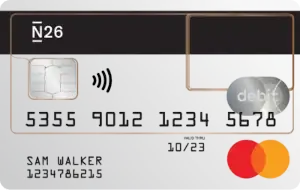
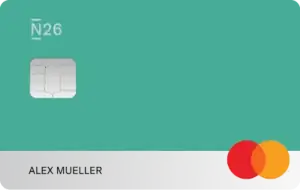
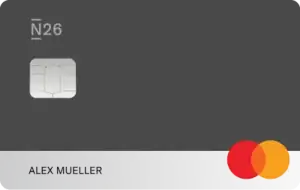
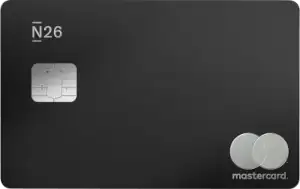
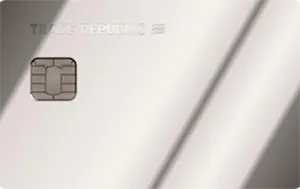
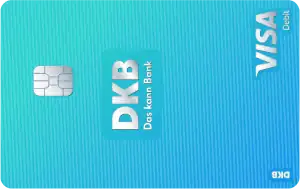
Charge Credit Cards
Charge cards allow you to make purchases throughout the month and repay the full amount at once, usually at the end of the billing cycle.
No interest is charged if the balance is paid in full and on time. With a charge credit card, you receive free credit for a limited period of time. Billing is typically monthly. This means you’ll receive a monthly credit card bill, which must be paid in full by the due date. Some credit card providers offer an extended interest-free payment period of up to 60 days.
These cards typically require a positive Schufa credit score and regular income.
In Germany, they are typically issued as Visa, Mastercard, or — to a lesser extent — American Express. Charge cards issued by banks are usually linked to a checking account at the same bank. Other providers accept any German checking account as a reference account. They are widely accepted in Germany and abroad, including for hotel bookings, car rentals, and flights.
The card provider predefines the credit card limit, which may increase over time with a good payment record. Unlike revolving cards, partial payments are not possible – the full amount is debited once per month.
Many charge cards come with additional services, depending on the provider and the card tier. These may include bonus and cash back programs, travel insurance, purchase protection, extended warranties, or discounts on hotel and car rental bookings. Some premium cards also include lounge access at airports, concierge service, and other VIP benefits.
Fees for charge cards vary. Some providers offer free credit cards with basic functions or even some additional benefits, while premium cards with extended benefits typically come with an annual fee.
American Express offers a wide range of charge cards in Germany, including two free options without an annual fee: the Amex Blue and the Amex Payback Card. These entry-level cards are well-suited for newcomers and shopping lovers. Higher-tier cards, such as the American Express Gold and Platinum Card, offer extensive additional benefits, including travel insurance, purchase protection, and airport lounge access. Users can also benefit from Amex Offers (merchant-specific cashback deals) and the Amex Membership Rewards program, which allows them to collect and redeem points for travel, shopping, or statement credits. The scope of services is tiered, allowing users to select a card that suits their needs and spending habits. However, cash withdrawals and foreign currency payments come with relatively high fees compared to other providers.
Pros & Cons
- Clear payment structure due to monthly settlement
- High acceptance in Germany and abroad
- Many cards include additional shopping- and travel-related benefits
- No interest if paid in full on time
- Requires Schufa check and proof of income
- No installment option
- Not suitable for those without a German current account
Best Charge Credit Cards in Germany
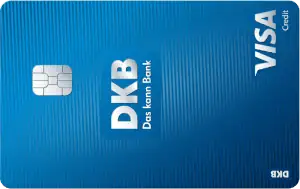
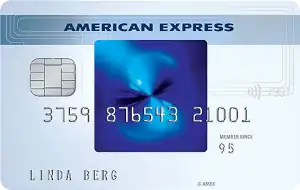
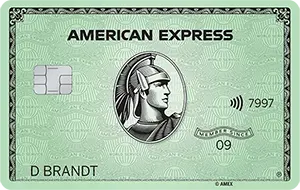
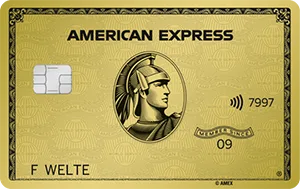
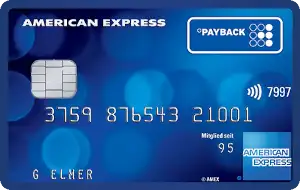
Revolving Credit Cards
Revolving cards allow you to carry a balance over several months and repay your spending in flexible monthly installments. Interest is charged on the outstanding balance.
Banks and fintechs offer revolving credit cards. Like charge cards, they are usually Visa or Mastercard and accepted worldwide. A positive Schufa score is required in nearly all cases, and the card issuer sets a credit limit based on your creditworthiness.
The cards grant a credit line that is usually unlimited in time. You pay it back in monthly installments. Typically, you can choose how much of your monthly balance to repay – usually a minimum percentage (e.g., 5–10 %). The remaining amount is carried over to the next billing period, and interest is added.
Additional services, such as insurance packages, cash back, and rewards programs, are often included, especially with premium models. However, interest rates on revolving cards tend to be high by German standards (on average 15–20% APR, with many cards even higher).
Some providers issue revolving cards independently of their current account, allowing you to use any German bank account as the reference account for the card. Others require you to open a checking account with them.
Fees for revolving credit cards depend on the card services.
Pros & Cons
- Flexible repayment
- High international acceptance
- Potential additional services (insurance, cashback, etc.)
- Available without a checking account in some cases
- Interest on outstanding balances
- Schufa check required
- Can encourage overspending
- Limited availability on the German market
Best Revolving Credit Cards in Germany
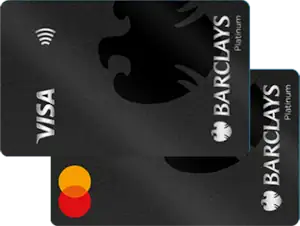
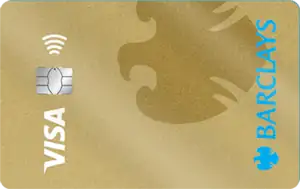
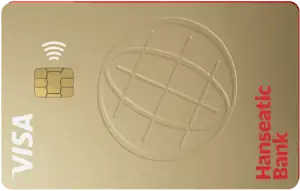
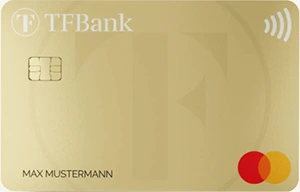
Revolving credit cards in Germany offer flexible repayment options. Cardholders can choose to use the card like a charge card, repaying the full amount monthly by a fixed due date and interest-free if paid on time. Extended payment terms often apply here. For example, repayments on the Barclays Bank credit cards remain interest-free for up to 59 days. Alternatively, you can activate installment payments, where only a portion of the balance is paid monthly, and interest is charged on the remaining amount.
Prepaid Credit Cards
Prepaid cards must be topped up in advance and can only be used to spend within the available balance. They are easy to obtain and typically don’t require a Schufa check or regular income. This makes them attractive for newcomers, students, or those with a not-so-good credit score.
Prepaid cards in Germany are either Visa or Mastercard. They can be used worldwide. However, their acceptance is limited, especially for car rentals, hotels, or some online services. Also, they typically don’t help build a credit history.
There are annual or monthly fees for the cards.
Additional services, such as cash back or insurance, aren’t available for prepaid cards. With these cards, you can only withdraw cash, pay for online purchases, or make other cashless payments.
The issuance of a prepaid credit card does not usually require you to have a checking account with the card provider. This can be a significant advantage for expats: you can use the card without needing to open a German bank account.
How to Top Up a Prepaid Credit Card in Germany
To add credit to your German prepaid card, you can use different options depending on your provider:
- Bank transfer (SEPA): Most common method to transfer money from a German or European bank account; funds are credited within 1–2 business days
- Instant bank transfer: Real-time SEPA transfer; depending on the provider, cost-free or with a small fee
- Via another credit card: Available for some prepaid providers; a service charge may be incurred
- Cash deposit at a partner location: Some providers allow top-ups at post offices and retail partners (supermarkets, kiosks, petrol stations)
- Standing order / recurring transfer: Useful for regular top-ups (e.g., monthly allowance, with a German or European euro bank account)
- Mobile payment apps: Most providers integrate with apps like Apple Pay or Google Pay, allowing users to load funds via linked accounts. Contactless payments via NFC are also standard.
- Voucher codes / PaysafeCard: Especially for virtual prepaid options; enter the code to credit the balance
Pros & Cons
- No credit check
- All basic functions of a credit card (worldwide acceptance, cash withdrawals, cashless and online payment)
- Depending on the card provider, available without permanent residence or a bank account in Germany
- No credit function
- Not accepted everywhere
- No Schufa score improvement
Best Prepaid Credit Cards in Germany
- Commerzbank Prepaid Mastercard
- Postbank Visa Card Prepaid
- Pay Center SupremaCard (Mastercard)
Prepaid credit cards make up only a small segment of the German card market. They are primarily used in special cases — for example, by people without a regular income or credit history. For most banks and consumers, debit cards are more prevalent due to their broader acceptance, integration with checking accounts, and enhanced functionality. Prepaid cards can be a temporary solution, but they rarely offer additional benefits, such as cash back, insurance, or credit-building potential.
Which Credit Card Type Is Best for Expats in Germany?
Choosing the right credit card type depends on your status in Germany, your income situation, and whether you already have a credit history with Schufa. Many expats arrive without a German credit score and need a solution that works immediately — for online payments, travel bookings, or everyday expenses.
- No Schufa, international acceptance, English-language apps
Most expats prioritize cards that don’t require a Schufa check, are accepted worldwide, and come with a user-friendly app in English. Visa and Mastercard debit cards from modern banks often meet these needs. - Debit cards for newcomers with no credit history
If you’re new to Germany and don’t yet have a local bank account or a credit score, a debit card linked to a mobile bank account (such as N26 or Revolut) is usually the easiest and fastest way to get started. - Charge cards for stability and bonus features
Once you’ve settled in and receive regular income, a charge card can offer more benefits — including travel insurance, loyalty programs, or purchase protection. These are ideal if you prefer monthly billing and want to avoid interest charges. - Revolving cards only for experienced users
Revolving credit cards should only be used if you have a steady income and understand how interest works. They offer repayment flexibility, but can become expensive if balances are carried over. - Prepaid cards only as a fallback
Prepaid credit cards are useful in very specific cases — for example, if you don’t yet have a bank account or want to avoid any credit checks entirely. However, they offer limited acceptance and no credit-building potential.
In summary, start with a debit card, then transition to a charge card or revolving card as your situation stabilizes, and use prepaid cards only when absolutely necessary. Use your revolving credit card interest-free like a charge card.
What to Consider When Choosing a Credit Card in Germany
Finding the right credit card in Germany isn’t just about the type of card — it’s about how well it fits your needs and financial situation as an expat. These are the most important aspects to look at before applying:
Schufa Requirements
Many traditional credit cards require a positive Schufa credit score. If you’re new to Germany and haven’t built up a credit history yet, you may want to start with a debit or prepaid card. Some modern fintechs (like N26, Revolut, or bunq) offer options without a Schufa check.
International Acceptance
Not all cards are equally accepted abroad. Ensure your card is branded as Visa or Mastercard, especially if you plan to travel. Cards connected to the Giro card network may not work outside Germany unless they have an international co-badge.
English-Language Support
Many expats feel more confident using cards that come with English-language apps and customer service — banks like N26, Revolut, or American Express offer full English-language interfaces and support.
Mobile Payments and App Functionality
Look for cards that support Apple Pay and Google Pay and come with a modern, easy-to-use app. Features like instant transaction notifications, spending analysis, and the ability to freeze your card can make daily banking much more convenient.
Additional Benefits
Depending on the card, you may gain access to travel insurance, cash back, reward programs, or even airport lounge access. These features are available with charge and revolving credit cards, as well as some premium debit cards.
General Value for Money
Don’t just look at the annual fee — compare it to what the card actually offers. A free card with no perks may be less attractive than a premium card with insurance, cashback, or rewards, especially if you benefit from those features.
Also consider the ongoing usage costs:
- Cash withdrawals: Many cards charge fees for ATM use, especially outside the EU. Others include a set number of free withdrawals per month. Some cards offer free cash withdrawals worldwide, but fees may still apply in Germany, depending on the provider. Some providers also limit how often you can withdraw money per month without incurring fees.
- Foreign currency payments: Many cards charge a fee of 1.75% to 2.50% per transaction when used outside the euro zone. Some premium or travel-focused cards waive this fee.
- Interest on outstanding balances: If you’re using a revolving card, check the APR (annual percentage rate, often 15–25 %) and understand when interest begins to accrue.
The best credit card is one that matches your spending habits, offers minimal fees for transactions, provides additional benefits that you actually use, and provides real value for the price. Always review the fine print to understand which benefits are included automatically and which require activation or a minimum spending requirement.
Free credit cards without annual fees are no longer limited to basic debit cards — they are increasingly available as revolving cards as well. Some of these no-fee cards offer benefits that rival or even exceed those of many paid credit cards.
The TF Bank Mastercard Gold and the Advanzia No-Fee Mastercard Gold are among the best free credit cards in Germany. Both cards offer no annual fee, worldwide acceptance, free cash withdrawals, and use without foreign currency fees, along with attractive perks such as travel insurance or no foreign transaction fees. Although these cards require a Schufa check, approval is often more flexible than with traditional German banks, especially if you have a stable income. This makes them an appealing option for expats with limited credit history who want access to premium-like benefits at no cost. However, both cards have high interest rates for installment payments.
Conclusion – Which Card Type Should You Choose?
For most expats, the safest starting point is a modern debit card from a provider offering English support and one that does not require a Schufa check. Once you have a regular income and establish a credit record, a charge card can provide greater benefits with no interest — as long as you pay on time. Revolving credit cards offer flexibility, but their high interest rates make them suitable only for experienced users with a solid budget. Prepaid cards, while accessible, should only be used when other options are not available. Always compare fees, perks, and usability before making your final decision.
Frequently Asked Questions — FAQ
Annual fees for credit cards in Germany vary significantly, depending on the card type and the benefits it offers. Prepaid cards may charge a small yearly or monthly fee. Debit cards are often issued free of charge, especially by mobile banks. However, they are usually linked to a checking account, which may incur monthly fees. Charge and revolving credit cards come in different pricing tiers: entry-level models are sometimes free, while premium cards with travel insurance, cashback, or lounge access can cost between €30 and over €600 per year.
To apply for a German credit card, you usually need to provide proof of identity and residency. This includes a valid passport or ID, proof of address (e.g., registration certificate/Meldebescheinigung), and proof of income (e.g., payslips or bank statements). Providers also require a positive Schufa score, mainly for cards with a credit function. The application process is often completed online and includes a digital identity check via video call or automated ID scan. For prepaid and some debit cards, fewer documents are needed, and a Schufa check may not be required.
You can manage your German credit card through the provider’s online banking portal or mobile app. Most cards allow you to view your current balance, track transactions in real time, and download monthly statements. Your credit card statement includes all charges, payments, and the total balance due for each billing cycle. You can usually freeze or unfreeze the card, set spending limits, activate or deactivate international or online payments, and monitor your credit card account for suspicious transactions or unusual activity. Some apps also let you switch between full repayment and installment options (for revolving cards). If your card includes benefits such as insurance, cash back, or rewards points, these are often displayed in a separate section. If you’re unsure how to make changes in the app, you can usually contact a customer service agent directly through chat, phone, or email for assistance.
While modern providers like N26, Revolut, or Barclays offer English-language apps with full functionality, traditional banks often have more limited interfaces and support only German.
Revolving credit cards in Germany come with the installment payment option (Teilzahlung) activated by default. This means only a small portion of your monthly balance is paid off automatically, while the remaining amount accrues interest. If you want to avoid interest charges and use your revolving card like a charge card — paying the full balance each month — you’ll need to change the repayment setting manually. Most providers allow this adjustment to be made directly within their app. To make the change, navigate to the payment settings or repayment section and select full repayment instead of partial repayment. Depending on the provider, this may be listed as “100% repayment”, “full balance”, or “Einmalzahlung”. Ensure that you confirm and save the setting to avoid interest charges on future statements.
The Giro card is a domestic payment system primarily designed for use in Germany. To work abroad, the card must carry an additional logo — a so-called co-badge — such as Maestro (by Mastercard) or V PAY (by Visa). However, support for both systems is being phased out. Most German banks stopped issuing new Maestro cards in 2023, and also replace V PAY with Visa Debit co-badge.
As a result, many Giro cards no longer function reliably at international ATMs, terminals, or online stores. If you travel frequently or shop online, it’s best to use a Visa Debit, Mastercard Debit, or a true credit card for international payments.